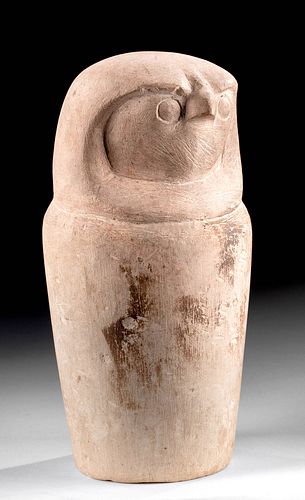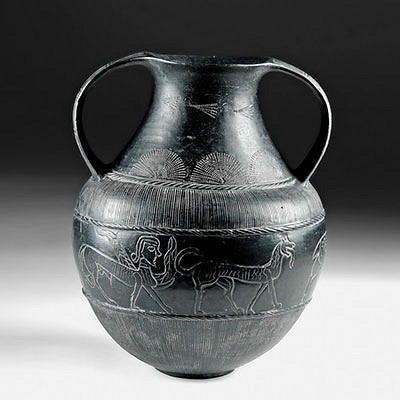Egyptian Stone False Canopic Jar Falcon Head
Lot 2
About Seller
Artemis Fine Arts
686 S Taylor Ave, Ste 106
Louisville, CO 80027
United States
Selling antiquities, ancient and ethnographic art online since 1993, Artemis Gallery specializes in Classical Antiquities (Egyptian, Greek, Roman, Near Eastern), Asian, Pre-Columbian, African / Tribal / Oceanographic art. Our extensive inventory includes pottery, stone, metal, wood, glass and textil...Read more
Categories
Estimate:
$9,000 - $14,000
Absentee vs Live bid
Two ways to bid:
- Leave a max absentee bid and the platform will bid on your behalf up to your maximum bid during the live auction.
- Bid live during the auction and your bids will be submitted real-time to the auctioneer.
Bid Increments
| Price | Bid Increment |
|---|---|
| $0 | $25 |
| $300 | $50 |
| $1,000 | $100 |
| $2,000 | $250 |
| $5,000 | $500 |
| $10,000 | $1,000 |
| $20,000 | $2,500 |
| $50,000 | $5,000 |
| $100,000 | $10,000 |
| $200,000 | $20,000 |
About Auction
By Artemis Fine Arts
Sep 17, 2020
Set Reminder
2020-09-17 10:00:00
2020-09-17 10:00:00
America/New_York
Bidsquare
Bidsquare : CLEARANCE - Ancient, Pre-Columbian, Ethno Art
https://www.bidsquare.com/auctions/artemis-gallery/clearance---ancient-pre-columbian-ethno-art-5605
End-of-Summer Clearance sale featuring discounted pricing on antiquities from Egypt, Greece, Italy, and the Near East...plus Viking, Asian, Pre-Columbian, Tribal, Russian Icons, Spanish Colonial, Fine Art, more! Starting prices have been reduced up to 65% from original auction prices. Artemis Fine Arts info@artemisfinearts.com
End-of-Summer Clearance sale featuring discounted pricing on antiquities from Egypt, Greece, Italy, and the Near East...plus Viking, Asian, Pre-Columbian, Tribal, Russian Icons, Spanish Colonial, Fine Art, more! Starting prices have been reduced up to 65% from original auction prices. Artemis Fine Arts info@artemisfinearts.com
- Lot Description
**Originally Listed At $5000**
Egypt, Third Intermediate Period, 21st to 25th Dynasty, ca. 1070 to 664 BCE. An intriguing and incredibly rare stone 'false' canopic jar (also known as 'dummy' jars) with smooth surfaces. The tapered cylindrical body rests upon a flat base and has a rounded shoulder, and the 'lid' is integral with the rim above the shoulder. The lid is sculpted to resemble the head of a falcon, with protruding hemispherical eyes, a furrowed brow, a petite aquiline beak, tapered cheeks, and a minimal chin, all framed within a simple bag wig. Traces of original red and white pigment are visible across the composition and suggest that the 'jar' was at one time painted with vivid colors. Size: 4.625" W x 9.125" H (11.7 cm x 23.2 cm).
Canopic jars are some of the most iconic artifacts from Egypt, made to hold internal organs removed during the mummification process. This tradition lasted for an incredibly long time - the first evidence for a canopic chest containing organs comes from the Fourth Dynasty (ca. 2600 BCE) and they were used into the late 1st millennium BCE. False canopic jars like this example were created during later dynastic periods starting in the 18th Dynasty for two primary reasons. First, they were created so less-wealthy individuals could symbolically partake in the rich funerary traditions of ancient Egypt. Expert stone carvers were needed to create open vessels to contain one's internal organs, and the drilling/boring process was an arduous process that cost a correspondingly large amount of money. Members of non-royal houses chose to use false jars as tomb offerings since they could be easily manufactured in less time. The second reason was so they would fool grave robbers - hence the name 'dummy' jars - so only a shapely piece of stone would be stolen.
The 18th Dynasty marked a shift in canopic jar tradition, when these jars were given to all people of status, and when their heads were fashioned to look like the four Sons of Horus, including Qebehsenuef. The Four Sons were charged with protecting the internal organs, as they had originally been charged with protecting the body of Osiris. The falcon-headed son who represented the west, Qebehsenuef, was charged with protecting the intestines of the deceased and was protected by the scorpion goddess Serqet.
Provenance: private J.H. collection, Beaverton, Oregon, USA; ex-private Los Angeles, California, USA collection; ex-private collection of a professor, New York, New York, USA, acquired in the 1970s
All items legal to buy/sell under U.S. Statute covering cultural patrimony Code 2600, CHAPTER 14, and are guaranteed to be as described or your money back.
A Certificate of Authenticity will accompany all winning bids.
We ship worldwide and handle all shipping in-house for your convenience.
#149641Minor abrasions to base, body, and lid, with light softening to some finer details, and fading to original pigmentation, otherwise intact and excellent. Faint traces of original pigment visible throughout.Condition
- Shipping Info
-
All shipping is handled in-house for your convenience. Your invoice from Artemis Gallery will include shipping calculation instructions. If in doubt, please inquire BEFORE bidding for estimated shipping costs for individual items.
-
- Buyer's Premium



 EUR
EUR CAD
CAD AUD
AUD GBP
GBP MXN
MXN HKD
HKD CNY
CNY MYR
MYR SEK
SEK SGD
SGD CHF
CHF THB
THB















